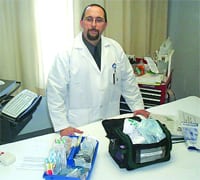Medical Society’s Physician Practice Environment Index Continues to Decline
WALTHAM — A recent Mass. Medical Society (MMS) analysis shows a prolonged decline in the state’s physician practice environment and points to continuing concerns affecting physicians that are likely to affect the delivery of care to patients.
The society released its annual MMS Physician Practice Environment Index, a statistical compilation of nine factors that influence the practice climate for physicians. For 2009, the index declined 0.8{06cf2b9696b159f874511d23dbc893eb1ac83014175ed30550cfff22781411e5}, representing a continued deterioration of the practice environment for physicians in Massachusetts. The index has declined in 16 of the 18 years the society has been compiling such data.
The decline in the Society’s 2009 Index was led by four factors: a growing burden of professional liability rates on physicians; an increasing use of emergency departments by patients; an aging physician workforce; and the increasing cost of maintaining a physician practice.
“The causes of the sustained decline in the practice environment have been with us for some time,” said Dr. Alice Coombs, MMS president, “and this analysis is significant because it carries implications for patients as well as physicians.
“A strong practice environment is essential to maintain a strong physician workforce,” she continued, “and both together mean better care for our patients. This becomes even more critical with universal coverage, given the added pressures that it puts on physicians, especially those in primary care specialties. The continued viability of physician practices should be a cause for concern about our state’s health care delivery.”
Of the four main factors causing the increase, the medical society called the increasing professional liability rates and the rise in emergency-department use by patients as the most troublesome.
Professional liability rates: Coombs said a critical step forward in improving the practice environment would be to enact liability reform, something that the medical society has been advocating for years. Liability-insurance rates advanced 4{06cf2b9696b159f874511d23dbc893eb1ac83014175ed30550cfff22781411e5} in Massachusetts in 2009.
“The high cost of liability rates has been the driving force behind the decline of the practice environment for years,” she said. “If there’s one step to take to begin to reverse the decline, it would be enacting liability reform.” Coombs said liability reform would also bring additional benefits in reducing the practice of defensive medicine, which would help to reduce costs throughout the health care system.
Roughly half of the physicians practicing in the state are experiencing liability costs that exceed 10{06cf2b9696b159f874511d23dbc893eb1ac83014175ed30550cfff22781411e5} of their total business costs, and some physicians in high-risk specialties like obstetrics and neurosurgery pay annual premiums in excess of $100,000. The society’s 2008 analysis of defensive medicine — tests, procedures, referrals, hospitalizations, or prescriptions ordered by physicians out of the fear of being sued — conservatively estimated the annual cost of this practice to be $1.4 billion in the state.
Emergency-department usage: The society said the rise in emergency-room use by patients, a phenomenon confirmed by other studies, “highlights a new and disturbing dimension” in the annual analysis, as it points to the delivery of primary care taking place in emergency departments. Nationally, visits to emergency departments rose 2.8{06cf2b9696b159f874511d23dbc893eb1ac83014175ed30550cfff22781411e5} in 2009; in Massachusetts they increased by 3.5{06cf2b9696b159f874511d23dbc893eb1ac83014175ed30550cfff22781411e5}.
The society reported that “emergency-department patient-utilization rates are not only increasing over time in Massachusetts relative to the U.S., but Massachusetts patients are also continuing to rely more intensively on emergency departments for their medical care, both on a per-hospital and per-capita basis. The average hospital emergency department in Massachusetts reported 40{06cf2b9696b159f874511d23dbc893eb1ac83014175ed30550cfff22781411e5} more patient visits than the average U.S. emergency department.”
Other key findings: The percentage of physicians over 55 years of age rose 3.2{06cf2b9696b159f874511d23dbc893eb1ac83014175ed30550cfff22781411e5}, an expected result, yet one that should raise concern as more physicians approach retirement age. Approaching retirements, coupled with continued and existing shortages of physicians in several specialties, especially those in primary care, may reduce access to care for patients and result in extended wait times for appointments.
Meanwhile, the average cost of maintaining a physician practice, including employer wages, office rental fees, and medical supplies, increased 3.0{06cf2b9696b159f874511d23dbc893eb1ac83014175ed30550cfff22781411e5} in Massachusetts in 2009, while the cost of maintaining a practice declined 1.3{06cf2b9696b159f874511d23dbc893eb1ac83014175ed30550cfff22781411e5} nationally.
A comparison shows that while the U.S. index for physician practice environment is advancing, the Commonwealth’s is declining. For 2009, the U.S. index increased 1.3{06cf2b9696b159f874511d23dbc893eb1ac83014175ed30550cfff22781411e5} its third consecutive rise. Since 2006, the Massachusetts index has declined 1.5{06cf2b9696b159f874511d23dbc893eb1ac83014175ed30550cfff22781411e5}, while the U.S. index has advanced 1.2{06cf2b9696b159f874511d23dbc893eb1ac83014175ed30550cfff22781411e5}.
The MMS Physician Practice Environment Index measures the impact of nine indicators that influence the practice environment for physicians in Massachusetts: the number of applications to Massachusetts medical schools, the percentage of physicians over age 55, the number of employment ads in the New England Journal of Medicine, median physician income, the ratio of housing prices to median physician income, professional liability costs, the cost of maintaining a physician practice, mean hours per week spent in patient care, and annual number of visits per emergency department. The complete index report may be read at www.massmed.org/mmsindex.


